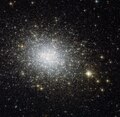Fichier:Potw1428a.tif

Taille de cet aperçu JPG pour ce fichier TIF : 614 × 600 pixels. Autres résolutions : 246 × 240 pixels | 491 × 480 pixels | 786 × 768 pixels | 1 048 × 1 024 pixels | 2 096 × 2 048 pixels | 3 222 × 3 148 pixels.
Fichier d’origine (3 222 × 3 148 pixels, taille du fichier : 29,19 Mio, type MIME : image/tiff)
Historique du fichier
Cliquer sur une date et heure pour voir le fichier tel qu'il était à ce moment-là.
| Date et heure | Vignette | Dimensions | Utilisateur | Commentaire | |
|---|---|---|---|---|---|
| actuel | 16 juillet 2014 à 01:48 |  | 3 222 × 3 148 (29,19 Mio) | Fabian RRRR | == {{int:filedesc}} == {{Information |Description ={{en|1='''The oldest cluster in its cloud This image shows NGC 121, a globular cluster in the constellation of Tucana (The Toucan). Globular clusters are big balls of old stars that orbit the cent... |
Utilisation du fichier
La page suivante utilise ce fichier :
Usage global du fichier
Les autres wikis suivants utilisent ce fichier :
- Utilisation sur de.wikipedia.org
- Utilisation sur el.wikipedia.org
- Utilisation sur en.wikipedia.org
- Utilisation sur fa.wikipedia.org
- Utilisation sur it.wikipedia.org
- Utilisation sur my.wikipedia.org
- Utilisation sur ro.wikipedia.org
- Utilisation sur vi.wikipedia.org